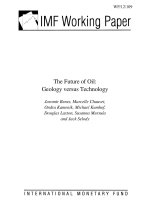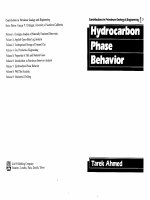GEOLOGY burcu gulses
Bạn đang xem bản rút gọn của tài liệu. Xem và tải ngay bản đầy đủ của tài liệu tại đây (2.31 MB, 33 trang )
REMOTE
SENSING
TO
GEOLOGY
The collection and
interpretation of
information about an
object without physical
contact with the object;
eg, satellite imaging,
aerial photography,
and open path
measurements.
Satellite remote
sensing has
become a common
tool to investigate
the different fields
of Earth and
environmental
sciences.
GEOLOGY
Remote sensing is used
as a tool to extract
information about the
land surface structure,
composition or
subsurface, but is often
combined with other data
sources providing
complementary
measurements.
Remote sensing is not
limited to direct geology
applications - it is also
used to support logistics,
such as route planning for
access into a mining area,
reclamation monitoring,
and generating basemaps
upon which geological
data can be referenced or
superimposed.
Geological applications of remote sensing include the
following:
surficial deposit / bedrock mapping
lithological mapping
structural mapping
sand and gravel (aggregate) exploration/ exploitation
mineral exploration
hydrocarbon exploration
environmental geology
geobotany
baseline infrastructure
sedimentation mapping and monitoring
event mapping and monitoring
geo-hazard mapping and planetary mapping
Geoenvironmental
research can help to
identify the causes of
these events, point
the way to
rehabilitation
measures, and lend
support for early
warning systems
Remote sensing adds
considerably to this
research by providing
a wide variety of
sensors operated
from airborne and
satellite platforms.
The GARS Program
of UNESCO and
IUGS provides a
means of continually
investigating the
geological
applicability of
remote-sensing
techniques.
The multispectral
scanner images from
the first nonmeteorological,
civilian Earth
observation satellites,
the US LANDSAT
series launched in
1972
The LANDSAT images
were received
enthusiastically by a
small scientific
community, mostly
geologists,
oceanographers and
geographers.
The GARS Program,
jointly sponsored by
UNESCO and IUGS,
was inaugurated in 1984
(Weber, 1985)
LANDSAT-1,and
LANDSAT-4, containing
Thematic Mapper, was
launched, adding an
additional three bands in
the SWIR (short-wave
infrared) to the existing
visible (VIS) and nearinfrared (NIR) bands.
Remote sensing has
become a widely
accepted research
tool by almost all
Geological Surveys
the world over.
Why remote
sensing?
A synoptic view of
regional scale is a
much different
perspective than
point ground
observations when
trying to map
structural elements.
Remote sensing offers
this perspective and
allows a geologist to
examine other
reference ancillary data
simultaneously and
synergistically, such as
geo-magnetic
information.
Remote sensing gives the overview required
to
1.Construct regional unit maps, useful for
small scale analyses, and planning field
traverses to sample and verify various units
for detailed mapping;
2.Understand the spatial distribution and surface
relationships between the units.
Remote sensing offers
this perspective and
allows a geologist to
examine other
reference ancillary
data simultaneously
and synergistically,
such as geo-magnetic
information.
Geologic Unit Mapping
Mapping geologic
units consists
primarily of
identifying
physiographic units
and determining the
rock lithology or
coarse stratigraphy
of exposed units.
Data requirements
Two different scales of mapping require slightly
different imaging sources and parameters:
1. For site specific analysis, airphotos provide a
high resolution product that can provide
information on differential weathering, tone, and
microdrainage. Photos may be easily viewed in
stereo to assess relief characteristics.
2. Regional overviews require large coverage area
and moderate resolution. An excellent data
source for regional applications is a synergistic
combination of radar and optical images to
highlight terrain and textural information.
Today, with each new satellite in space, some of
the previous work has to be repeated in order to
test the new technologies. This has led to a
wider acceptance of remote sensing for
geological applications and it has found its place
among the disciplines of the earth sciences.









